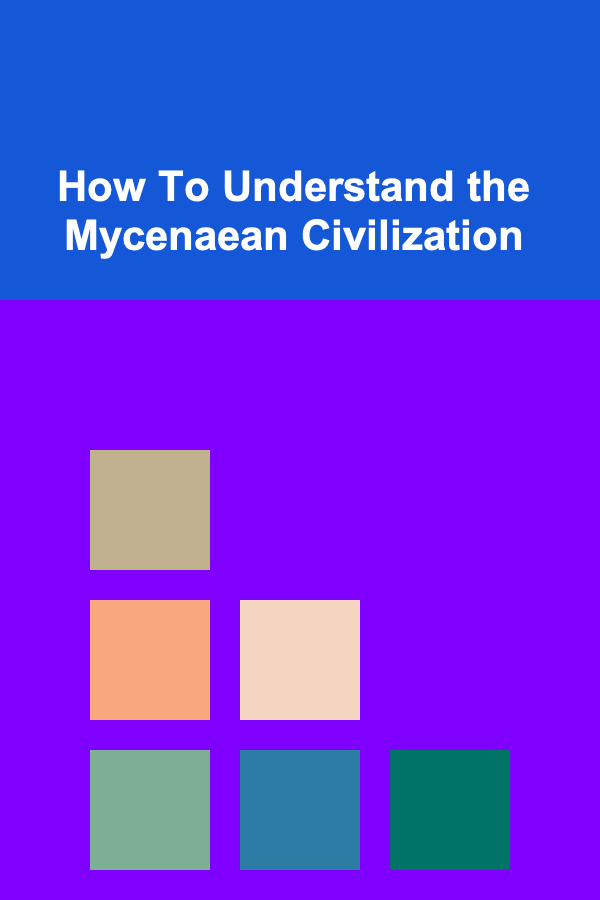
How To Understand the Mycenaean Civilization
ebook include PDF & Audio bundle (Micro Guide)
$12.99$6.99
Limited Time Offer! Order within the next:

The Mycenaean civilization, which flourished in the Aegean region from around 1600 BCE to 1100 BCE, represents one of the most significant and influential cultures of the ancient Mediterranean world. As the precursor to Classical Greece, the Mycenaeans laid the foundation for many aspects of Greek culture, including art, architecture, and religious practices. Despite their substantial contributions, much about the Mycenaeans remains a mystery. This article aims to explore the key elements that help us understand this enigmatic civilization, focusing on its history, culture, economy, social structure, and legacy.
The Rise of the Mycenaean Civilization
Origins of the Mycenaeans
The Mycenaeans were part of a broader group of Indo-European peoples who migrated to the Greek peninsula in the second millennium BCE. They are generally considered to be descendants of the earlier Minoan civilization, which thrived on the island of Crete before them. Around 1600 BCE, the Mycenaeans began to establish themselves on the Greek mainland, particularly in the Peloponnese, where they built large, fortified cities like Mycenae, Tiryns, and Pylos. Their cultural achievements were influenced by the Minoans, but they also developed a distinct identity that set them apart.
The Mycenaean Political Landscape
The Mycenaean world was organized around a system of palace economies, where powerful rulers controlled the surrounding regions from large, fortified citadels. These palaces acted as centers of political, economic, and religious activity. Mycenaean society was structured hierarchically, with a king or "wanax" at the top, followed by a complex bureaucracy that helped manage agricultural production, trade, and military affairs.
Each Mycenaean kingdom had its own palace, but there were strong interconnections between them, likely through trade, diplomatic relations, and military alliances. Mycenae, the most famous of these centers, gave the civilization its name and was one of the most prominent powerhouses in the Aegean world.
The Decline of the Mycenaeans
Around 1200 BCE, the Mycenaean civilization experienced a sudden and dramatic decline. The reasons for this collapse are still debated by scholars. Some suggest that it was the result of internal factors, such as economic instability or the collapse of the palace system. Others point to external forces, including invasions by the Sea Peoples, natural disasters, and the disruption of trade networks. Whatever the cause, the decline of the Mycenaeans marked the end of an era in the Aegean, leading to the Greek Dark Ages.
Mycenaean Art and Architecture
Palaces and Fortifications
One of the most remarkable features of Mycenaean civilization is its architecture. The Mycenaeans built large, complex palaces and fortifications, some of which are still standing today. The citadel of Mycenae, with its massive walls, is perhaps the most iconic of these structures. The walls were made of large, roughly hewn stones, a construction technique known as "cyclopean masonry" because ancient Greeks believed that only giants, or cyclopes, could have lifted such enormous stones.
The palaces were organized around a central courtyard, with rooms for the king, his family, and the palace staff. Many of the palaces also featured large, elaborate throne rooms, where the king would hold court and make decisions about the kingdom's affairs. These palaces were not only residential but also served as administrative and religious centers.
In addition to the palaces, the Mycenaeans built fortified cities, complete with defensive walls and gates. The famous "Lion Gate" at Mycenae, with its iconic relief of two lions standing over a column, is a prime example of Mycenaean artistry and architectural ingenuity.
Mycenaean Art
Mycenaean art is best known for its pottery, frescoes, and metalwork. The pottery was often decorated with geometric patterns, as well as scenes of animals and daily life. Some of the most exquisite examples of Mycenaean pottery come from the tombs of wealthy individuals, where they were used as grave goods.
Frescoes found in the palaces depict scenes of court life, religious ceremonies, and warfare. One of the most famous examples is the fresco at Knossos, which depicts a grand banquet scene. The frescoes provide valuable insights into the social and political life of the Mycenaeans, showing them as a warrior culture with a strong emphasis on ritual and prestige.
In addition to pottery and frescoes, the Mycenaeans were skilled metalworkers. They produced intricate jewelry, weapons, and tools from gold, bronze, and other metals. Some of the most famous Mycenaean artifacts, such as the golden death mask of Agamemnon, demonstrate the level of craftsmanship achieved by Mycenaean artisans.
The Mycenaean Economy
Agriculture and Trade
The Mycenaean economy was primarily agricultural, with most people working as farmers. The fertile plains of the Greek mainland, particularly in the Peloponnese, allowed the Mycenaeans to produce a variety of crops, including wheat, barley, olives, and grapes. The Mycenaeans also raised livestock, such as sheep, goats, and cattle, which were essential for their economy.
Trade played a critical role in the Mycenaean economy. The Mycenaeans established extensive trade networks that spanned the Mediterranean, reaching as far as Egypt, the Levant, and Anatolia. They traded a variety of goods, including wine, olive oil, textiles, and pottery, in exchange for luxury items such as gold, ivory, and precious stones.
The Mycenaeans were also known for their shipbuilding and maritime prowess. Their ships were used for both trade and warfare, allowing them to establish dominance over the seas and secure their economic interests. The palaces of the Mycenaeans served as hubs for trade, where merchants would bring goods from far-flung regions.
The Role of the Palaces in the Economy
The Mycenaean palaces played a central role in the economy, functioning as administrative centers for the collection and redistribution of resources. The palaces maintained extensive record-keeping systems, including clay tablets inscribed in Linear B, an early form of Greek. These tablets contain detailed accounts of agricultural production, labor, and trade, offering a glimpse into the highly organized and bureaucratic nature of Mycenaean society.
The palaces also controlled large estates and had the power to tax the population. The wealth generated from agriculture, trade, and tribute from surrounding regions allowed the rulers of the Mycenaean cities to maintain their power and prestige.
Mycenaean Society and Culture
Social Structure
The social structure of Mycenaean society was hierarchical, with a clear distinction between the elite and the common people. At the top of the hierarchy was the king, or "wanax," who ruled over a large region and was often associated with divine authority. The wanax was supported by a class of nobles and administrators who managed the affairs of the palace and the surrounding territories.
Below the elite were the artisans, farmers, and laborers, who formed the backbone of Mycenaean society. These individuals worked the land, produced goods, and performed the manual labor required to support the palaces and the economy. Slavery was also a part of Mycenaean society, with prisoners of war and others being forced into servitude.
Religion and Beliefs
Religion played a central role in Mycenaean culture. The Mycenaeans believed in a pantheon of gods and goddesses, many of whom were later incorporated into Greek mythology. The most prominent deity was likely Zeus, the king of the gods, who was worshipped as the god of the sky and thunder.
In addition to Zeus, the Mycenaeans worshipped a variety of other deities, including Poseidon, Athena, and Apollo. Religious practices included offerings, sacrifices, and elaborate rituals, which were often conducted in the temples and sanctuaries of the palaces.
The Mycenaeans also had a strong belief in the afterlife. Burial practices varied, but the wealthier members of society were often buried with grave goods, such as weapons, jewelry, and pottery. This suggests a belief in an afterlife where these items would be useful to the deceased.
Language and Writing
The Mycenaeans used a form of writing known as Linear B, which was an early form of Greek. Linear B was used primarily for record-keeping purposes, particularly in the palaces, and has provided valuable insights into the Mycenaean economy, society, and culture. The script was deciphered in the 1950s by Michael Ventris, revealing that the Mycenaeans were not only capable administrators but also highly organized in terms of their political and economic systems.
Despite the advancements in written language, the Mycenaeans did not leave behind many literary works, and their oral traditions were passed down through the generations. It is believed that the epic poems of Homer, such as the Iliad and the Odyssey, were inspired by the events and heroes of the Mycenaean period.
The Legacy of the Mycenaean Civilization
Influence on Ancient Greece
The Mycenaean civilization left a profound impact on later Greek culture. Many of the myths, legends, and religious practices that formed the foundation of Classical Greek culture can be traced back to the Mycenaeans. The heroic age depicted in the works of Homer is based on the world of the Mycenaeans, and the warriors, gods, and cities of that period became central figures in Greek mythology.
In addition to mythology, the Mycenaeans also influenced Greek art, architecture, and language. The use of monumental stone architecture, such as the Tholos tombs , carried over into later Greek structures. Similarly, the development of Greek writing and the use of the Greek alphabet were influenced by the script of the Mycenaeans.
Archaeological Discoveries
Archaeological excavations of Mycenaean sites have provided a wealth of knowledge about this ancient civilization. The discovery of the palaces at Mycenae, Tiryns, and Pylos, along with the thousands of Linear B tablets, has allowed historians and archaeologists to piece together the details of Mycenaean society. Excavations have also uncovered a wealth of artifacts, including pottery, jewelry, and weapons, which provide further insights into the material culture of the Mycenaeans.
Conclusion
Understanding the Mycenaean civilization is essential for grasping the roots of ancient Greek culture and its enduring influence on Western civilization. From their advanced architecture and art to their complex social and political systems, the Mycenaeans were a remarkable society that laid the groundwork for many aspects of Greek culture. While much of their history remains shrouded in mystery, ongoing archaeological research continues to shed light on this fascinating civilization, offering new insights into their way of life, beliefs, and legacy.
Reading More From Our Other Websites
- [Home Pet Care 101] How to Choose the Best Pet Exercise Equipment for a Healthy Lifestyle
- [Metal Stamping Tip 101] How to Implement Lean Manufacturing Principles in a Metal Stamping Production Facility
- [Home Maintenance 101] How to Install a Smart Thermostat: Step-by-Step Guide
- [Personal Care Tips 101] How to Use Toner for Acne-Prone Skin: A Comprehensive Guide
- [Home Budget Decorating 101] How to Decorate with Plants (Even if You Have a Black Thumb) & Save Money
- [Home Cleaning 101] How to Maintain a Dust-Free Home with Simple Techniques
- [Personal Care Tips 101] How to Remove Waterproof Mascara Easily
- [Home Budget Decorating 101] How to Decorate Your Home Affordably with Second-Hand Finds
- [Home Rental Property 101] How to Screen Tenants Like a Pro (Beyond Credit Scores)
- [Home Budget Decorating 101] How to Use Statement Pieces to Update Your Space for Less

How to Create a Home Library with Smart Storage Solutions
Read More
How to Market Your Home Rental Property Effectively
Read More
How to Set Up a Seasonal Recipe Book for Easy Reference
Read More
Mastering Sun Salutations for Energy Flow
Read More
How to Create Intricate Wood Carvings: A Step-by-Step Tutorial
Read More
10 Tips for Staying Up-to-Date with ERP Technology Trends
Read MoreOther Products

How to Create a Home Library with Smart Storage Solutions
Read More
How to Market Your Home Rental Property Effectively
Read More
How to Set Up a Seasonal Recipe Book for Easy Reference
Read More
Mastering Sun Salutations for Energy Flow
Read More
How to Create Intricate Wood Carvings: A Step-by-Step Tutorial
Read More